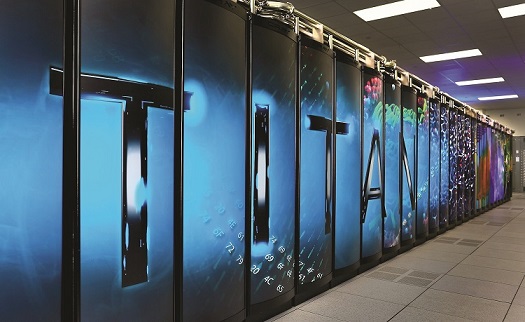|
Department of Physics and Astronomy Volume 8, Number 2 |
 |
|---|
| Location The University of Tennessee Knoxville, Tennessee, USA http://www.phys.utk.edu |
Key Contact Dr. Hanno Weitering Professor and Head Telephone: (865) 974-3342 E-mail: hanno@utk.edu |
Overview
The Department of Physics and Astronomy is a large, diverse department with strong research efforts balanced between theory and experiment. With resources both on campus and at nearby Oak Ridge National Laboratory, faculty and students explore studies in biophysics, computational astrophysics, condensed matter, high energy physics, nuclear physics, and other fields. Joint Institutes in Advanced Materials, Heavy Ion Research, and Neutron Sciences encourage collaborative and multi-disciplinary research, as do interactions with scientists at key facilities all over the world.
Research Focus Areas
Astrophysics: The astrophysics group is a joint UT-ORNL collaboration whose primary scientific focus is on explosive stellar events and the associated nuclear astrophysics. These efforts profit immensely from world-class computational resources such as ORNL's Titan and UT's Kraken that are available to us. We use such tools to construct theoretical models for supernovae, nova, x-ray, and gamma-ray bursts. All of these events create new atomic nuclei and contribute them to the galaxy, forming the basis for new stars and planets. By studying these events and their nuclear products, which form much of ourselves and our world, we study an important link in the chain of history that connects us to the beginning of the Universe.
Recent Highlights: Recent publications by the astrophysics group highlight the improvements in our understanding of core collapse supernovae that have come from more sophisticated models. These new multi-dimensional models, which resolve the spectra of the neutrinos that carry off the binding energy of the newly-formed neutron star, exhibit a much slower development of the supernova explosion. In contrast to prior models, which tracked only the mean energy of the neutrinos, our current models are less efficient at depositing neutrino energy into the matter, requiring a longer period to build up the energy of the explosion to the point where it can lift the stellar envelope. We anticipate that this longer delay between the formation of the neutron star and the generation of the supernova explosion will have consequences observable in the supernova’s neutrino and gravitational wave signals, as well as the nucleosynthesis that results.
Biophysics: Biophysicists at UT explore cellular biophysics, soft matter physics, and theoretical biological physics. Research includes the study of self–organizing processes in prokaryotic cells and the development of micro- and nano-fabricated environments to carry out long-term high resolution microscopy of bacteria. Theory work explores the application of statistical physics, stochastic processes, and nonlinear dynamics to the dynamical behavior and the collective phenomena in complex biological systems. Other investigations involve multi-disciplinary studies of polymer dynamics, glass transition, the dynamics of biological macromolecules, and nano-composite and nano-structured materials, as well as nano-optics and plasmonics.
Recent Highlights: Using neutron and light scattering experiments and molecular dynamics simulations, UT scientists have helped show how measuring protein flexibility can help explain certain protein behaviors. By separating whether such flexibility is the result of elastic vibrations or actual conformational alterations, researchers can better elucidate protein properties. Research at the intersection of physics, biology, and nanotechnology explores how bacteria are organized at the cellular level and how that structure responds to perturbations, as well as how cell shape influences basic processes such as cell division and chromosome replication. Starting with silicon wafers, the group develops lab-on-a-chip environments (about the size of a U.S. penny) to study E. coli. Such studies bring with them interesting possible applications: locating vulnerabilities in cell organization, for example, could help define new targets for antibiotics.
Chemical Physics: Although interdisciplinary in character, the field of Chemical Physics is quite broad, covering everything from elementary excitations in atoms, to the theory of weakly bound complexes, to nanoscience and technology involving novel materials. The chemical physics program at UT brings together scientists from several academic departments, with research in superconductivity and magnetism, polymer science, weakly bound complexes, laser spectroscopy, negative ions, and chirality.
Recent Highlights: The chemical physics program has made a number of major advances in the understanding of chiral molecules and chiral molecular interactions. They have reported both experimental and theoretical studies of optical activity for the biologically important molecule carvone in the gas and solution phase. They are also part of a collaboration to investigate the stereochemical differences in interaction between enantiomers of chiral molecules and are working on studies of negative ions of chiral molecules.

(Courtesy of the Oak Ridge Leadership Computing Facility.)
Condensed Matter Physics: The principal goal of materials science is to understand, and predict, just what properties will result from the combination of particular types of atoms into bulk matter. Condensed matter research at UT draws on the strength experimentalists and theorists to solve these puzzles. Theory investigations cover correlated electrons, electron transport in nanostructures, diluted magnetic semiconductors, and computational methods. Experimentalists study strongly-correlated electron materials, as well as the microscopic origin of high-transition temperature (Tc) superconductivity and the physics of novel materials, including the discovery of new materials with abnormal physical properties. The group also studies materials for energy storage and technological applications such as sensors, electronics, and displays. Other areas of interest are nanoscale superconductors, magnetic nanowires and atom wires, and materials for hydrogen storage and spintronics.
Recent Highlights: The condensed matter group has been at the forefront of research on iron-arsenic superconductors, discovered in 2008, and provided a recent review of these materials for Nature Physics. Current research has focused on strongly-correlated electron systems, with experimental work using neutron scattering and angle-resolved photoemission techniques. Recent theoretical studies have focused on superconducting iron selenides and oxide interfaces, using sophisticated theoretical models to describe the phase diagram of these materials. A recently acquired oxide molecular beam epitaxy growth system and new 0n-campus crystal-growth facilities will provide new tools to strengthen the group’s efforts.
High Energy/Particle Physics: Physicists in UT’s high energy group are involved in world-wide collaborations to understand the properties of the most fundamental particles. With key contributions to the Compact Muon Solenoid detector (CMS) at CERN’s Large Hadron Collider, they study elementary particles at very high energies to address issues including particle mass, matter and anti-matter, and extra dimensions. They have been heavily involved with the KamLAND experiment that showed that neutrinos have mass and are now part of international efforts to measure neutrino mass, map the hierarchy of neutrino masses, and investigate whether CP-symmetry is violated in neutrino interactions. The theory group is working on the developing subject of black holes and other extended objects in string theory.
Recent Highlights: The 2012 announcement from CERN that scientists are growing ever-closer to discovery of the elusive Higgs Boson was the result of world-wide scientific collaboration, and UT’s high energy physicists are part of that effort. They work with the international team that built and maintains the LHC's Compact Muon Solenoid detector, which can observe remnants of proton collisions and track their signatures. The group remains active with the KamLAND experiment and the NOvA and Double Chooz collaborations devoted to understanding the properties of neutrinos. The theory group has made significant contributions toward the understanding of strongly-coupled superfluids at large chemical potential and continues efforts leading to new and more efficient tools for the calculation of higher-order radiative corrections to scattering amplitudes of processes.
Nuclear Physics: Nuclear physics is a strong and active research group at UT. With access to supercomputing facilities both at the university and ORNL, theorists are leading a national endeavor to develop a comprehensive description of all nuclei based on the fundamental interaction of their protons and neutrons. Experimentalists test nuclear many body theories at extreme conditions measuring the properties of nuclei and nucleonic matter with accelerated stable and radioactive ion beams at national facilities. Experiments in nuclear astrophysics give insight into the nuclear reactions in stars, essential for understanding the conditions whereby chemical elements are synthesized by nuclear processes. A newly-opened beamline at the Spallation Neutron Source will allow scientists to use neutrons for the study of beta decay and parity violation, and to search for the electric dipole moment.
Recent Highlights: Using the Jaguar supercomputer at ORNL, UT’s nuclear physicists used nuclear density functional theory, or DFT, to theoretically assess the boundaries of the nuclear landscape and predict that 6900 (±500) nuclei exist: more than double the number currently known. The group has also begun data collection for parity experiments at the Spallation Neutron Source at ORNL. Other current studies investigate nuclear structure and its role in the r-process, which is believed to occur in type II supernovae explosions. UT’s nuclear physicists play an active role in the ALICE and PHENIX experiments to investigate the quark-gluon plasma and the origins of the universe.